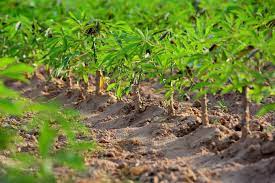Cultivated cassava feeds the world – staple food for 1 billion people worldwide, by Moritz Bausch in conversation with Thomas Wegener, founder of Grow Express Ltd., Ibadan, Nigeria
The „potato of the tropics“, is almost unknown in Europe. But cassava is one of the five most important crops worldwide and shines with its versatile use. But there is still a lot of room for improvement: Breeders are working on its small blemishes, which can be adapted biologically correct.
It is worth knowing that cassava, also known as yuca, is one of the most important staple foods in many tropical countries around the world. The very starchy tubers of the shrub plant can be boiled, fried or roasted similar to the potato. Their flavor is neutral to slightly sweet in most varieties. Purees are popular, as are breads, cookies and cakes made from the gluten-free flour. But there is much more of interest. About a quarter of global production goes into livestock feed as cassava starch or tapioca. And FAO, the Food and Agriculture Organization, also certifies the tropical plant’s suitability as a renewable raw material for ethanol production. This is particularly true if its yield potential can be exploited through professional cultivation.
Development work by Grow Express Ltd in Nigeria – model plant
And this is where GrowExpress comes in. In very close cooperation with the International Institute of Tropical Agriculture (IITA) (one of the world’s largest seed banks), GrowExpress puts the scientific findings into practice economically on its own cultivation areas, thus making an economically valuable contribution to basic nutrition in Nigeria. The International Institute of Tropical Agriculture (IITA) is an internationally active research institution founded in 1967 and based in Ibadan, Nigeria. Its mission is to improve livelihoods in Africa through agricultural research.
Appearance and characteristics of the cassava bush
 The tubers of the cassava bush are about 50cm long, 10 cm thick and 2-4 kg in weight. The skin is reddish brown, the inside is whitish. The main component is starch. However, depending on the variety, they also contain the glycoside linamarin in large quantities. When injured, this is converted into toxic prussic acid, which protects the plant from predators and can also be dangerous to humans. Therefore, these tubers must not and should not be eaten raw. By repeated watering or much better strong heating lowers the content to a harmless level.
The tubers of the cassava bush are about 50cm long, 10 cm thick and 2-4 kg in weight. The skin is reddish brown, the inside is whitish. The main component is starch. However, depending on the variety, they also contain the glycoside linamarin in large quantities. When injured, this is converted into toxic prussic acid, which protects the plant from predators and can also be dangerous to humans. Therefore, these tubers must not and should not be eaten raw. By repeated watering or much better strong heating lowers the content to a harmless level.
The tubers have another flaw: they contain plenty of starch, but unfortunately not much else. If cassava is used as the sole food, deficiency symptoms can result from low protein, vitamin, iron or zinc contents. In recent years, successes have been achieved with seed developments that increase the vitamin B6 content and reduce the linamarin value.
One of the reasons why GrowExpress also relies on the cassava plant, which originates from South and Central America, is the ideal local conditions with
tropical temperatures around 25°C, well-distributed rainfall, plenty of sunshine and loose soil in your fields. Furthermore, cassava can withstand prolonged periods of drought and grows well in poor soils.
Procedure of Grow Express Ltd
After planting the cuttings, about 1 meter apart, perennial shrubs about 3 meters high are produced, which form harvestable tubers after about 12 months. GrowExpress now achieves up to 30 tons per hectare with locally bred and adapted varieties after many years of improvement.
At the final stage of maturity, GrowExpress growers look closely at the discoloration of the shrub’s leaves, which indicate a high starch content in the tubers at absolute harvest maturity. The stems are then cut off and the tubers are taken out of the ground. Since the tubers spoil only a few days later, GrowExpress processes a large part of its harvest on site to produce longer-lasting flour or one of the Nigerian staple foods garri This prevents the crop loss of up to 40 percent after harvest, which is still widespread in Africa. Furthermore, additional permanent jobs are created which are urgently needed in the agricultural sector to counteract further migration to the cities or abroad.
 World production of cassava in 2020 was around 300 million tons (potatoes: around 400 million tons). This put the crop in the TOP 10 of the world’s most important crops. The main producers are Nigeria followed by DR Congo, Thailand, Indonesia and Brazil. The average yield of all countries is 11 tons per hectare.
World production of cassava in 2020 was around 300 million tons (potatoes: around 400 million tons). This put the crop in the TOP 10 of the world’s most important crops. The main producers are Nigeria followed by DR Congo, Thailand, Indonesia and Brazil. The average yield of all countries is 11 tons per hectare.
Grow Express will continue to work very closely with international institutes and local universities to improve quality and yields in order to increase the current 30 tons per hectare, with a clear focus on environmental sustainability, which will provide even more people in Nigeria with a basic food guarantee at affordable prices.
V.i.S.d.P.:
Moritz Roland Bausch
OTA Training & Blogger
About the author:
Moritz Bausch, a graduate of the English boarding school Rossall School in Fleetwood, United Kingdom, with the International Baccalaureate Diploma (IB). Moritz is currently in vocational training OTA in healthcare. He is particularly interested in the transformation of healthcare – with human health at the forefront – through technology, digitalization and artificial intelligence to holistic A-Z health.
Company description:
The GrowExpress office located in Nigeria Cocoa House, Dugbe, 200263 Ibadan, Nigeria. Completed in 1965 at a height of 105 meters, Cocoa House was once the tallest building in Nigeria and the first skyscraper in West Africa. It is located in Dugbe, one of the main commercial areas in Ibadan, Oyo State, Nigeria.
PRESSEKONTAKT
GrowExpress Limited
Kingsley Ekwueme – Managing Director
Cocoa House, Dugbe
200263 Ibadan, Nigeria
Website: https://growexpress.org
E-Mail : AtYourService@growexpress.biz
Telefon: +234 7031135981



